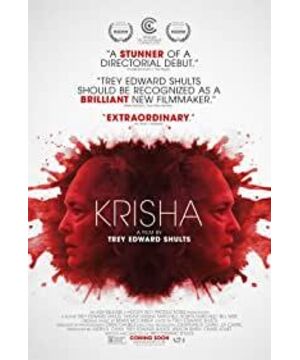Krisha is a film with more distinctive shooting techniques and soundtrack. This kind of lens and soundtrack can quickly give the audience a sense of substitution, and their own emotions follow the protagonist's psychological state all the way. The angle of the film and the lens cover seemed to be shot directly in the heart of the hostess. Crowded, crowded, and mostly close-up. Sometimes the spacious upper space of the house is used to contrast the relationship between the characters, especially the relationship between Krisha and others. Most of the characters appear in pairs, and they are very close and emotionally intimate. There is only "heterogeneity", such as Krisha, who is described as an "outer" at the beginning of the lens, always appears alone in a lens, and the scene is small and big, highlighting the facial expressions and eyes of the characters. When the door was opened, the young man looked at Krisha and then closed the door and drove away his dog, it can be seen that she is not a welcome visitor. Her son always gave the camera alone, explaining that he did not have a deep relationship with the other cousins of the family. From the beginning, he entered the house with sunglasses, ignoring the mother Krisha in front of him, and turning straight into the kitchen. The audience can clearly feel a sense of distance. As the only character in the film who wears sunglasses, he is also in addition to Krisha. The most silent one outside. Sunglasses represent his concealment of his feelings. He doesn't want people to see the thoughts of his mother's return, but when he put down his things and came to hug his mother, although he was somewhat restrained, he could still be seen shaking slightly and tearing with his hands. Krisha's room is on the corner of the second floor, which is also a sign of her marginalized image. There are many contrasting shots. For example, when Krisha came out of her room for the first time soon after the beginning of the film, and looked down at the lively life of her sister's family under the stairs, the camera gave a fast cross-sectional shot, sweeping across her floor, and then we Seeing her starting to go downstairs, the camera was shown downstairs. The younger sister’s son was playing pinball and trying to bounce up to the ceiling, giving a vertically stretched visual image. This is a horizontal and vertical contrast. As the audience is familiar with the camera angle, a large number of family members’ various shots interspersed in the middle and late stages of the film fully interpret the protagonist’s inner emotions. At the same time, this expression method is combined with the soundtrack at the end of the film to push the film together. To the climax. It is a work directed very carefully. The roles are also well chosen.
View more about Krisha reviews










